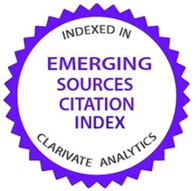Modelo de compartimentação da adsorção dos explosivos dos solos para determinar seu destino ambiental
DOI:
https://doi.org/10.47741/17943108.184Palavras-chave:
munições, explosivos, ambienteResumo
A finalidade desta pesquisa era identificar as características principais do solo que influenciam a adsorção dos constituintes de munições (MC) dos explosivos nos solos, através de um modelo de compartimentação para determinar o destino dos explosivos. Para fazer a pesquisa, experimentos em lote perto do solo de 1:1 (w/v) das proporções da solução que refletem condições do campo foram conduzidas usando uma mistura de HMX, de RDX, nitroglicerina (NG), de nitroguanidina (NQ), TNT e 2.4-dinitrotolueno como MC, onde a mistura de MC adsorvida em vinte e cinco solos diferentes que variaram o índice da argila de 4.0 a 43. 2% e o carbono total de 0.07 a 18.23 %, em uma experiência que demandou 2 dias da adsorção seguidos por quatro etapas consecutivas de dessorção. O resultado o mais importante foi que para cada MC, mesmo se estivesse em uma mistura, os coeficientes de partição foram preditos com sucesso usando o carbono orgânico, a capacidade de troca e o ferro extraível como as características principais do solo que determinam o destino destes explosivos.
Downloads
Referências
ARDEC (2008). US Army RDECOM Armament Research, Development & Engineering Center, AMSRD-AAR-AEE-P, Picatinny Arsenal, NJ.
Blume, H. P. & Schwertmann, U. (1969). Genetic evaluation of profile distribution of aluminium, iron, and manganese oxides. Soil Science Society of American Journal, 33: 438-444.
Chappell M. A. (2011). Solid-Phase Considerations for the Environmental Fate of TNT and RDX in Soil Soil and Sediment Geochemistry. Team Lead, Environmental Laboratory, U.S. Army Engineer Research and Development Center (ERDC), 3909 Halls Ferry Road, Vicksburg, MS.
Chemical Properties Database. Groundwater Services, Inc., Houston, TX. 2010. Retrieved from http://www.gsi-net.com/UsefulTools/ChemPropDatabaseHome.asp. (accessed April 2012).
ChemIDPlus Lite, National Library of Medicine, Bethesda, MD (2006). Retrieved from http://toxnet.nlm.nih.gov (accessed April 2012).
De Kimpe, E. R., Laverdiere, M. R. & Martel, Y. A. (1979). Surface area and exchange capacity of clay in relation to mineralogical composition of Gleysolic soils. Canadian Soil Science Journal, 59: 341-347.
Del Campillo, M. C. & Torrent, J. (1992). A rapid acid-oxalate extraction procedure for the determination of active Fe-oxide forms in calcareous soils. Angenommen, 28: 437-440.
Dontsova, K. M., Hayes, C., Pennington, J. C. & Porter, B. (2009). Sorption of high explosives to water- dispersible clay: influence of organic carbon, aluminosilicate clay, and extractable iron. Journal of Environmental Quality, 38: 1458-1465.
HSDB Hazardous Substances Data Bank, National Library of Medicine, Bethesda, MD (2008). Retrieved from http://toxnet.nlm.nih.gov (accessed April 2012).
Gong, P., Siciliano, S. D., Greer, C. W., Paquet, L., Hawari, J. & Sunahara, GI. (1999). Effects and bioavailability of 2,4,6-trinitrotoluene in spiked and field-contaminated soils to indigenous microorganisms. Environmental Toxicology and Chemistry, 18: 2681-2688.
Gotz, R., Steiner, B., Sievers, S., Friesel, P., Roch, K., Schworer, R. & Haag, F. (1998). Dioxin, dioxin-like PCBs and organotin compounds in the river Elbe and the Hamburg harbour: Identification of sources. Water Science and Technology, 37: 207-215.
Hawari, J. & Halasz, A. (2002). Microbial degradation of explosives, in The Encyclopedia of Environmental Microbiology. Bitton G., Ed., John Wiley & Sons Ltd., Amsterdam, Netherlands.
Kaplan, D. L. & Kaplan, A. M. (1982). 2,4,6-Trinitrotoluene surfactant complexes - decomposition, mutagenicity, and soil leaching studies. Environmental Science & Technology, 16: 566-571.
Keng, J. K. C. & Uehara, G. (1973). Chemistry, mineralogy, and taxonomy of Oxisols and Ultisols. Soil & Crop Science Society of Florida, 33: 119-126.
Material Safety Data Sheet of 2,4 DNT (2008). OSHA.
Michalkova, A., Szymczak, J. J. & Leszczynski, J. (2005). Adsorption of 2,4-dinitrotoluene on dickite: The role of H-bonding. Structural Chemistry, 16: 325-337.
Monteil-Rivera, F., Groom, C. & Hawari, J. (2003). Sorption and degradation of octahydro-1,3,5,7-tetranitro- 1,3,5,7-tetrazocine in soil. Environmental Science & Technology, 37: 3878-3884.
Monteil-Rivera, F., Paquet, L., Deschamps, S., Balakrishnan, V. K., Beaulieu, C. & Hawari, J. (2004). Physico-chemical measurements of CL-20 for environmental applications. Comparison with RDX and HMX. J. Chromatogr. A, 1025: 125-132.
Myers, T. E., Brannon, J. M., Pennington, J. C., Townsend, D. M., Davis, W. M., Ochman, M. K., Hayes, C. A. & Myers, K. F. (1998). Laboratory studies of soil sorption/transformation of TNT, RDX, and HMX. Technical Report IRRP-98-8. U. S. Army Engineer Waterways Experiment Station, Vicksburg, MS.
Nefso, E. K., Burns, S. E., McGrath, C. J. (2005). Degradation kinetics of TNT in the presence of six mineral surfaces and ferrous iron. Journal of Hazardous Materials, B123: 79-88.
Pennington, J. C. (2002). Distribution and Fate of Energetics on DoD Test and Training Ranges: Interim Report 2, ERDC TR-02-08. Engineer Research and Development Center, prepared for US Army Corps of Engineers, Washington, DC.
Pennington, J. C., Thorn, K. A., Hayes, C. A., Porter, B. E. & Kennedy, K. R. (2003). Immobilization of 2,4- and 2,6- Dinitrotoluenes in Soils and Compost. Technical Report ERDC/EL. TR-03-2. U.S. Army Corps of Engineers, Waterways Experiment Station, Vicksburg, MS.
Pennington, J. C. & Patrick, W. H. (1990). Adsorption and desorption of 2,4,6-trinitrotoluene by soils. Journal of Environmental Quality, 19: 559–567.
Ran, Y., Sun, K., Yang, Y., Xing, B. S., Zeng, E. (2007). Strong sorption of phenanthrene by condensed organic matter in soils and sediments. Environmental Science & Technology, 41: 3.952-3.958.
Robidoux, P. Y., Hawari, J., Thiboutot, S., Ampleman, G. & Sunahara, GI. (2001). Chronic toxicity of octahydro-1,3,5,7-tetranitro-1,3,5,7-tetrazocine (HMX) in soil determined using the earthworm (Eisenia andrei) reproduction test. Environmental Pollution, 111: 283-292.
Schwarzenbach, R. P., Gschwend, P. M. & Imboden, D. M. (2003). Environmental Organic Chemistry, John Wiley & Sons, Inc., Hoboken, New Jersey.
Soil Colloids Course. University of Tennessee (2007). Retrieved from http://web.utk.edu/~drtd0c/Soil%20Colloids.pdf (accessed October 2013).
Sparks, D. L. (2003). Environmental Soil Chemistry, Academic Press, San Diego, CA.
Sposito, G. (2000). Handbook of Soil Science. CRC Press, Boca Raton, FL.
Sunahara, GI., Lotufo, G., Kuperman, R. G. & Hawari, J. (2009). Ecotoxicology of Explosives. CRC Press, Boca Raton, FL, USA.
Schwertmann, U. (1964). Differenzierung der Eisenoxide des Bodens durch Extraktion mit Ammoniumoxalat- Losung. Z. Pflanzenernahr. Dung Bodenk, 105: 194-202
Schwertmann, U. (1973). Use of oxalate for Fe extraction from soils. Canadian Journal of Soil Science, 53: 244-246.
Travis, E. R., Bruce, N. C. & Rosser, S. J. (2008). Short term exposure to elevated trinitrotoluene concentrations induced structural and functional changes in the soil bacterial community. Environmental Pollution, 153: 432-439.
U.S., Environmental Protection Agency (2006). Nitroaromatics, nitramines and nitrate esters by high performance liquid chromatography (HPLC). Method 8330B. SW846. Office of Solid Waste, Washington, DC.
U.S. General Accounting Office (2003). GAO 04-147. Military munitions: DOD needs to develop a comprehensive approach for cleaning up contaminated sites. Report to the Honorable John D. Dingell Ranking Minority Member, Committee on Energy and Commerce, House of Representatives, Washington, D. C.
U.S. Department of Health and Human Services (1995). Toxicological profile for 2,4,6 Trinitrotoluene.
Walsh, J. T., Chalk, R. C. & Merritt, C. (1973). Application of liquid chromatography to pollution abatement studies of munition wastes. Analytical Chemistry, 45: 1.215-1.220.
Xue, S. K., Iskandar, I. K. & Selim, H. M. (1995). Adsorption- desorption of 2,4,6-trinitrotoluene and hexahydro-1,3,5-trinitro-1,3,5-triazine in soils. Soil Science, 160: 317-327.
Yamamoto, H., Morley, M. C., Speitel, G. E. & Clausen, J. (2004). Fate and transport of high explosives in a sandy soil: Adsorption and desorption. Soil & Sediment Contamination, 13: 459-477.
Zhang, D. M., Zhu, D. Q. & Chen, W. (2009). Sorption of nitroaromatics to soils: comparison of the importance of soil organic matter versus clay. Environmental Toxicology and Chemistry, 28: 1.447-1.454.
Downloads
Publicado
Edição
Seção
Licença
Licencia creative commons CC BY NC ND https://creativecommons.org/licenses/by-nc-nd/2.0/





















